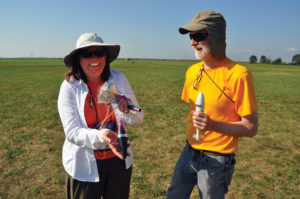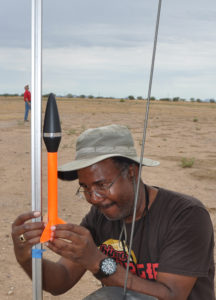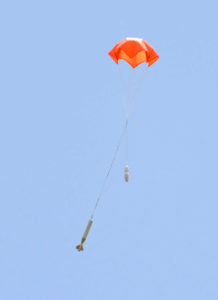Eggloft
 OVERVIEW
OVERVIEW
Eggloft combines the challenge of flying a model containing one or (for “Dual” Eggloft) two eggs while trying to reach the highest altitude (Eggloft Altitude) or longest duration (Eggloft Duration) possible. The eggs must be returned undamaged. If any egg is cracked or broken, the flight is disqualified. You may NOT catch the egglofter; it must be allowed to land naturally. Eggs must be 57 to 63 grams in weight, no more than 45 millimeters in diameter. This is typically a “Large” grade of egg.
For the full rules for this event, please see the Egglofting Altitude rules, Dual Egglofting Altitude rules, Egglofting Duration rules, and Dual Egglofting Duration rules in the Model Rocket Sporting Code.
SCORING
The contestant may make one or two flights. Up to two models may be used. The score is the best SINGLE qualified flight’s performance (altitude or duration) of the two flights allowed, if both are returned.

GENERAL TIPS
by George Gassaway, NAR 18723
There are two general design approaches: an egglofter with a long tapered conical shroud such as the Two Minute Egg (see plan below) (Aerospace Specialty Products (ASP) has a similar kit); or a straight body-tubed model with capsule on top.
Straight bodies have simplicity going for them, while shrouded bodies have lower drag and also have reliability in their favor due to the larger recovery system storage space. A straight body tube with a larger diameter, such as 1.3″ to 1.65″ diameter (BT-55, 35mm, BT-60) can be used. The model will be draggier and usually heavier and therefore at a competitive disadvantage. Some regular models you might already have can be adapted to fly as an eggloft altitude model by replacing the nose cone with a capsule. But they cannot be too heavy or they just will not fly safely enough with the added weight of an egg.
Build Well. A key to any event is building the model to fly straight and true. Work towards attaching all of the fins so they are straight and parallel to the body. This should translate to a straight boost, with minimal wobbling that would hurt the altitude. The faster the model boosts, the more strongly it needs to be built, to avoid shredding the fins at high speed.
Egg Capsule. Apogee offers a vac-formed egg capsule.
Another capsule sometimes used is a plastic Easter Egg, of a size that is just a little bigger than an egg. Such capsules use two “long halves” from two 1.75″ diameter Easter eggs, rather than one plastic egg due to the short half with a flange sticking out, as the flange limits the inside diameter too much. However, Easter Egg capsules that small can be hard for the eggs to fit in and be safely cushioned. Eggs tend to vary significantly in diameter, so Easter Egg capsules are somewhat risky. It’s best not to risk using a too-cramped capsule.

Dual Egg Extension. A lot of people like to convert single egg capsules to carry two eggs by using an extension tube. This serves two purposes. One, of course, is to simply be able to convert a single egg capsule. But there is another reason. By gluing in a bulkhead in the middle, the two eggs can be isolated from each other. Too often, eggs get broken at liftoff, or landing, because of the forces of one egg being transferred into the other egg. By using an extension with a bulkhead in the middle, the eggs can be packed so they are isolated, one egg cannot apply force to break the other egg.
Padding. Use foam or some other flexible material to try to cushion the egg so it will not get cracked. My favorite basic cushioning is to get hold of a foam egg carton and cut out the four corner “cups” as they fit the egg pretty well. I add other thin foam padding as well. The egg needs to be padded enough that it can’t rattle, but don’t pack it so tight that it’s under pressure when loaded in the capsule. If you are using a plastic capsule, don’t bother with putting the egg inside of a plastic bag….if the egg breaks you can just clean the capsule with water, without any damage.
Parachute. In Eggloft Altitude, the trick is to balance using a chute size that will not land so hard that the egg might crack, versus using a bigger chute that may let the model drift too far off to recover. For Eggloft Altitude, using a commercial type chute canopy is usually OK. You don’t want to use a canopy so thin that it rips easily.
Shroud lines can be “button and carpet thread”, which is what most manufacturers use.
To avoid the lines pulling loose from the parachute under stress, the shroud lines can be attached to run over the top of the chute. See the tip page on high strength parachutes. Also see the article below by Andy Jackson on parachutes for Egglofters.
For Eggloft Duration the chute needs to be relatively big so it can get good duration, though not so big that the model drifts away. Very big chutes of 48″ diameter or more are good for D Dual Eggloft duration, as long as it can be deployed RELIABLY. However, a model could drift too far away on even a 36″ chute if there is a lot of wind or it hits a big thermal. It is best to have several chutes of different sizes, and select the one that seems most suitable for the conditions.
Commercial chutes as sold by big manufacturers such as Estes can be used. However, these chutes are limited in size, are pretty thick, and are somewhat inefficient due to only six shroud lines. Homemade chutes are better. You can have a larger diameter, use more shroud lines (8, 12, or even 16 lines), and use a thin material that packs well in limited space. Some people like to use 1/4 mil mylar, some prefer to use colored dry cleaner bags or other pre-colored very thin plastic, and some prefer to use 1/4 mil “dropcloth” plastic with color added by use of a large black or red magic marker. Another plastic chute material source, not as thin as 1/4 mil dropcloth but pre-colored, is an inexpensive emergency poncho.
For a really good competitive Eggloft Duration model, you may want to have chutes larger than 36″. At some point it comes down to how large of a chute you can pack into the model, which can be reliably ejected out and deploy. This again is why a model with a larger body is recommended over a model with a smaller or shorter body, as there is a lot more room to store and deploy a chute from.
Shock Cords. It is useful to use a long shock cord that can actually absorb the shock of deployment, given the weight involved with egglofters. 1/8″ elastic works very well for that purpose for small egglofters (D and below, use 1/4″ for larger models), but is not ideal to attach directly to the body tube. Many competitors prefer to use a length of 100 pound or greater grade Kevlar cord to attach to the body tube (especially for mounting inside), then tie the elastic shock cord to the other end of the Kevlar cord. The 2-Minute Egg plan mentions using wire cable in a similar way to link elastic to the model. This method was used before Kevlar came into use for contest models, so Kevlar can be used rather than wire cable for the 2-Minute Egg. Unfortunately, the very hot ejection charge of a motor can burn a Kevlar shock cord if it is attached within the first 3″ or so of the ejection end of the engine, so the Kevlar cord needs to be mounted away from the heat blast or protected from the heat.
Tracking Powder. If optical tracking is being used for Eggloft Altitude, it is highly recommended to use tracking powder in your model visibility. See the tip page on Tracking Powder for more information.
MOTOR SELECTION
Egg payloads are heavy, so you need a higher-thrust motor to get the rocket off the pad at a good velocity and to avoid weathercocking. You also will not want the longest delay times in most cases below the E power class. Use C6-5 rather than C6-3, for example. If your egglofter goes past apogee and starts building up some downward velocity before ejection, the stress on the shock cord and parachute at ejection (already high due to the egg’s weight) will be very hard to manage without something ripping or separating.
KITS
–Plastic Egg Capsules (single egg) – Apogee Components
–Plastic Egg Capsules (single egg) – Custom Rocket Company
Related Documents:
| Armadillo B-C EL Duration (Irvine) | May 28, 2014, 5:40 am | 193 KB | |
| Competition Egglofting (Wolf) | May 28, 2014, 5:40 am | 1 MB | |
| Dual Egglofting (Wolf) | May 28, 2014, 5:40 am | 5 MB | |
| E Dual Eggloft (Feveryear) | May 28, 2014, 5:40 am | 12 KB | |
| E Eggloft Altitude (Wolf) | May 28, 2014, 5:40 am | 463 KB | |
| Eggloft Duration (Steele & Gassaway) | May 28, 2014, 5:40 am | 83 KB | |
| Eggloft Parachutes (Jackson) | May 28, 2014, 5:40 am | 26 KB | |
| Pprangroc C EL (Burzynski) | May 28, 2014, 5:40 am | 31 KB | |
| Sprint C Eggloft Duration (Beyers) | May 28, 2014, 5:40 am | 62 KB | |
| TwoMinuteEgg B-C EL (Gassaway) | May 28, 2014, 5:40 am | 80 KB |